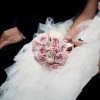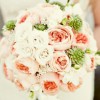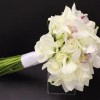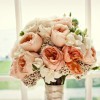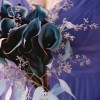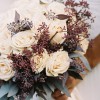Wedding flowers are steeped in history and symbolism. The tradition of a bride carrying or wearing flowers stretches back into ancient history. To our knowledge the earliest herbs and flowers to be incorporated into the wedding ceremony was dill, garlic, marigolds, thyme and sage, among other rather strong-smelling herbs and spices that were thought to ward off evil spirits, ill health and bad luck.
Another explanation for the tradition of the bouquet, according to http://www.herlifemagazine.com/ explains “In ancient times, a bride was considered especially lucky on her wedding day. So, guests were compelled to tear off parts of her dress to obtain a good luck talisman for themselves! Not all brides cared for this activity, as it seemed unpleasant to have their clothing ripped bit by bit, compliments of the guests. So it evolved, that the bride outsmart her guests by giving an offering of herself; enabling a guest to obtain a lucky talisman and allowing herself to keep her clothing intact: she starting throwing her garter and bouquet in lieu of pieces of her dress.”
In later times flowers evolved into symbols of love, fragility and fertility. They became the precious way to adorn the bride on the day of the ceremony and have become one of the most important aspects of her attire.
Many people assign their own personal meanings for flowers and the selection of wedding flora reflects these sentiments. Currently, with an overabundance of options to choose from the key deciding factors have become seasonality, sentiment and the overall color theme for the wedding party and décor.
For those interested in the historic connotation of flowers, this could be an exciting way to compose your bridal bouquet. This symbolism looks something like; Freesia, innocence; Blossoms, promise; Hyacinth, sincerity; Hydrangea, perseverance; Iris, inspiration; ivy, fidelity; lilac, first love; Calla Lily, regality; Peony, healing; Ranunculus, radiance; Roses, everlasting love; Stephanotis, good luck; and Zinnia, friendship.
One could also consider the overall color palette to evoke the desired tone. Cool colors are both comforting and nurturing. Blues, greens and neutral whites, greys and silver reflect these properties. Warm colors convey optimism and excitement. The warmth of red, fiery orange, hot pink and yellow as well as the neutral quality of black, gold and bronze carry warm attributes. There is also direct meaning associated with the colors of the spectrum such as; Blue – strength, intelligence; Green – growth, harmony; Gold – richness, extravagance; Orange – energy, vibrancy; Pink – sweet, romance delicate; Red – passion, love; Yellow- happiness, joy; White-purity.
The most important consideration in selecting your bouquet is seasonality and character. Your floral palette enables you to express yourself through the flowers themselves. When meeting with your floral coordinator to discuss your options this will be one of the first conversations that you have. You will begin to develop your palette based on preference, character, theme, season and venue. Together, with a designer, you will be walking down the aisle with a bouquet that perfectly encapsulates the energy and style of your day.
